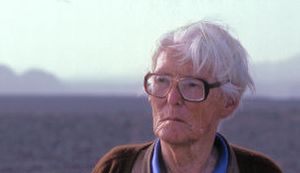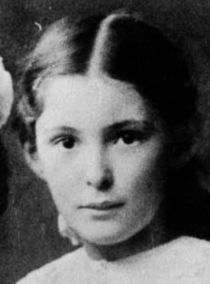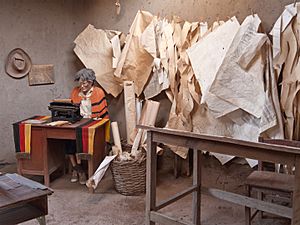Maria Reiche facts for kids
Quick facts for kids
Maria Reiche
|
|
|---|---|

Maria Reiche in 1986
|
|
| Born | 15 May 1903 |
| Died | 8 June 1998 (aged 95) |
| Alma mater | Dresden Technical University |
| Known for | Nazca Lines |
| Scientific career | |
| Fields | Archaeology |
Maria Reiche Grosse-Neumann (born May 15, 1903 – died June 8, 1998) was a German-born Peruvian scientist. She was a mathematician, an archaeologist, and a translator. Maria Reiche is famous for her important work studying the Nazca Lines in Peru. She first saw these mysterious lines in 1941 with an American historian named Paul Kosok.
People called her the "Lady of the Lines." Maria Reiche dedicated her life to learning about, protecting, and sharing information about the Nazca Lines. She was known as the main person caring for these ancient drawings. She even lived nearby to help keep them safe.
Her work helped the Nazca Lines get attention from all over the world. Peru officially protected them. In 1994, the lines became a UNESCO World Heritage Site. This means they are recognized as very important to human history. After she passed away, her home in Nazca became the Museo Maria Reiche. An airport and many schools in Peru are also named after her. In 2018, Google honored her with a special drawing on her birthday.
Contents
Early Life and Studies
Maria Reiche was born in Dresden, Germany, on May 15, 1903. Her parents were Felix Reiche Grosse and Ana Elizabeth Neumann. She went to the Technische Universität Dresden for her studies. There, she learned about mathematics, astronomy, geography, and different languages. She became very good at languages and could speak five of them.
In 1932, Maria moved to Peru. She worked as a governess, teaching the children of the German consul in Cusco. In 1934, while still in Cusco, she had an accident. She hurt her finger with a cactus and lost it due to an infection.
By 1939, she was teaching in Lima. She also worked on translating scientific papers. When World War II started that year, Maria decided to stay in Peru. The next year, she met Paul Kosok, an American historian. He was studying old irrigation systems in Peru. Maria helped him with his plans in the country. In 1941, she took a flight with him. This was her first time seeing the Nazca Lines from the sky. They worked together for many years. They tried to figure out how the lines were made and why.
Discovering the Nazca Lines
In 1940, Maria Reiche became an assistant to Paul Kosok. He was a historian from Long Island University in Brooklyn, New York. Kosok was studying ancient ways of watering crops in Peru.
In June 1941, Kosok noticed some lines in the desert. These lines met at a point where the sun sets during the winter solstice. This is the shortest day of the year in the Southern Hemisphere. Maria and Paul then started to map the lines. They wanted to see how they related to events in the sky. Later, Maria found lines that met at the summer solstice. This is the longest day of the year. She began to think the lines were a giant calendar based on the sky.
Around 1946, Maria started mapping the animal and bird shapes in the Nazca Lines. She found there were 18 different kinds of animals and birds.
Maria Reiche's Research and Protection Efforts
Paul Kosok left Peru in 1948. Maria Reiche then continued the work on her own. She used her math skills to figure out how the Nazca people could have made such huge drawings. She discovered that the lines were made with amazing mathematical accuracy. Maria believed the people who built the lines used them as a sun calendar. She also thought they were an observatory for studying stars and planets.
Since the lines look best from above, she asked the Peruvian Air Force for help. They took aerial photos for her. Maria worked alone from her home in Nazca. She wrote a book about her ideas called The Mystery on the Desert (first published in 1949). She thought the large drawing of a monkey might represent the constellation Ursa Major, also known as the Great Bear. Scholars had different opinions about her book. Most experts later agreed that the lines were not mainly for astronomy. However, Maria and Kosok's work brought a lot of attention to these amazing drawings. Some researchers now think the lines were part of religious ceremonies. They might have been used to ask the gods for water.
Maria used the money from her book to help protect the Nazca desert. She hired guards to watch over the area. She also hired assistants to help her with her work. A new road, the Pan American Highway, was being built. It cut through one of the Nazca figures. Maria spent a lot of money to talk to government officials and teach people about the lines. She wanted to keep them safe from damage. She paid for private security first. Then, she convinced the government to limit who could go into the area. She also helped build a tower near the highway. This tower lets visitors see the lines from above without harming them. Maria's efforts helped the lines become a World Heritage site in 1994.
In 1977, Maria Reiche helped start South American Explorers. This is a group that helps with travel, science, and education. She was on their advisory board. She also gave interviews about how important the Nazca Lines are.
Later Life
As Maria Reiche got older, her health became weaker. She needed a wheelchair to move around. She also had skin problems and lost her eyesight. In her last years, she also had Parkinson's disease. When she was 90 years old, she published another book. It was called Contributions to Geometry and Astronomy in Ancient Peru.
Maria Reiche passed away from ovarian cancer on June 8, 1998. She died at a hospital in Lima, Peru. She was buried with her sister, Dr. Renate Reiche-Grosse, near Nazca. She received special honors at her burial. A street and a school in Nazca are named after her.
See also
 In Spanish: Maria Reiche para niños
In Spanish: Maria Reiche para niños



